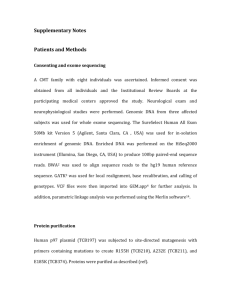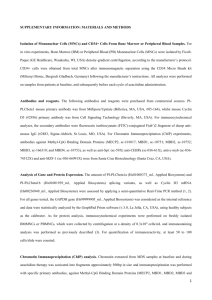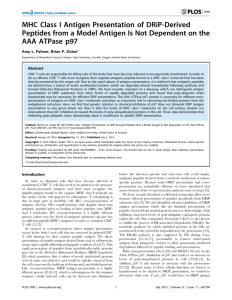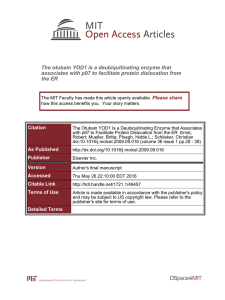Supplemental References
advertisement
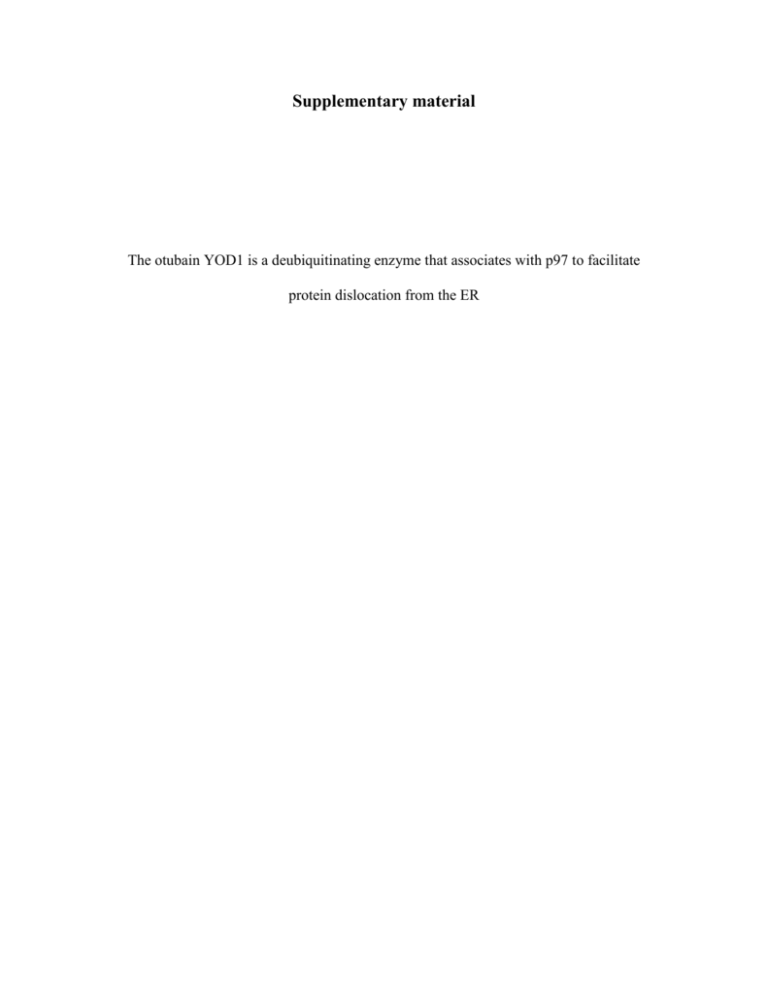
Supplementary material The otubain YOD1 is a deubiquitinating enzyme that associates with p97 to facilitate protein dislocation from the ER Figure S1. Identification of p97/NPL4/UFD1 as YOD1 interacting proteins. HeLa cells stably expressing YOD1 equipped with a C-terminal HA tag were homogenized and subjected to immunoprecipitation with anti-HA antibodies. Nontransduced Hela cells served as control. Immunoprecipitates were eluted by TEV protease cleavage, resolved by SDS-PAGE and subjected to silver staining. Gel pieces were processed for trypsinization and analyzed by LC-MS/MS. Depicted are the identified proteins that were absent from samples derived from the control (YOD1 itself was also identified but is not depicted). The positions of the peptides that were identified are highlighted in yellow, and in red in the corresponding amino acid sequence below. The tables summarize parent ion masses and sequence coverage. Figure S2. Purified YOD1 associates with p97 and is catalytically active in vitro. (A) GST-tagged YOD1 (25 µg) and a deletion mutant lacking the UBX-domain were incubated with purified, hexameric p97 (7.5 µg). As control served a deletion variant of p97 lacking the N-domain. After pulldown using glutathione-beads the GST-YOD1 variants and associated p97 were eluted with SDS-sample buffer and subjected to SDSPAGE (12%). (B) The catalytic activities of Wild-type YOD1 and YOD1 C160S (both 2.6 µM) were determined with UbAMC (10 µM) as a substrate. (C) YOD1 or its mutant derivatives were incubated with a 1.5-fold molar excess of HAUbVME and subjected to SDS-PAGE. HA-UbVME adduct formation was visualized by immunoblotting using anti-YOD1 antibodies (upper panel). Adduct formation was confirmed by immunoblotting with anti-HA antibodies (lower panel). (D) K63-linked poly-Ub chains (2 µg) were incubated for 16 h in a total volume of 10 µl with different YOD1 variants (7.7 µM). Poly-Ub and free Ub were detected by immunoblotting using anti-Ub antibodies. Figure S3. RI332 expressed in 293T cells is only partially N-glycosylated. (A) 293T cells were transiently transfected with wild-type RI332 or a mutant version that cannot be N-glycosylated (N275T), pulse labeled for 10 min with SDS. The lysates were subjected to anti-RI 35 S and lysed in 1% immunoprecipitation. The immunoprecipitated material was eluted with 1% SDS and either left untreated or incubated with PNGase F or Endo H according to the manufactures recommendations. The eluates were then separated by SDS-PAGE (12%) and visualized by autoradiography. Note that a fraction of RI332 is non-glycosylated when immunoprecipitated from 293T cells and that PNGase F treated RI332 has a slightly lower electrophoretic mobility as compared to Endo H treated RI332 probably due to the N275D substitution through PNGase F. (B) Schematic representation of various glycosylated, deglycosylated, and nonglycoylated RI332 variants produced by mutagenesis and enzymatic deglycosylation. Nacetylglycosamine is represented in blue, mannose in green, and the polypeptide chain of RI332 in orange. Figure S4. The degree of RI332 stabilization by YOD1 C160 is comparable to proteasomal inhbition. (A) 293T cells were transfected with an HA-tagged RI332 variant and either YOD1 WT or C160S. 24 hours after transfection cells were pulse-labeld with 35S for 10 min, chased for the indicated time points, lysed in 1% SDS and subjected to immunoprecipitation with anti-HA antibody. A separate batch of cells transfected with YOD1 WT and HA-tagged RI332 was treated with 50 µM ZL3VS during 30 min starvation period, the pulse-labeling and throughout the chase time to inhibit the proteolytic activity of the proteasome. The eluates were resolved by 12% SDS-PAGE and visualized by autoradiography (upper panel). Unbound material was immunoprecipitated with anti-Flag antibodies to verify equal expression of the YOD1 constructs (lower panel). (B) Densiometric quantification of recovered RI332 after indicated chase times in (A). Figure S5. YOD1 C160S expression increases the steady state level of RI332. (A) 293T cells were transfected with RI332 and either YOD1 WT or C160S. After 24 hours the cells were lysed with 1% SDS and subjected to immunoblotting with anti-RI antibodies. Equal expression of YOD1 WT and C160S was verified by an immunoblot with anti-Flag antibodies. A cross-reaction of anti-rabbit-HRP antibodies serves as loading control. (B) Immunoblots with anti-HA antibodies show the distribution of HA-Ub in cell lysates prior to immunoprecipitation with anti-p97 (as shown in Figure 6). Immunoblots with Anti-Flag and were performed to verify equal expression of Flag-tagged YOD1 and p97 variants. Equal loading is controlled by an immunoblot with anti-PDI antibodies. Figure S6. Polyubiquitin chains of proteins associated with p97 QQ are cleaved by purified YOD1. (A) 293T cells were co-transfected with p97 QQ and HA-tagged ubiquitin. After 24 hours p97 QQ and associated proteins were retrieved by immunoprecipitation with anti-Flag antibodies. To visualize poly-ubiquitin chains, the eluates were either directly subjected to immunoblotting with anti-HA antibodies or after a 5 h incubation with purified YOD1 variants (5 µg) at 37ºC in buffer A. Figure S7. YOD1 deubiquitinates dislocation substrates en route to the cytosol. The model depicts the two possible fates of dislocation substrates. In the presence of YOD1 WT, substrates are deubiquitinated to facilitate their threading through the p97 pore, leading to a progressive movement of the substrate to the cytosol (I-III). In the presence of catalytically inactive YOD1 C160S, the Ub chain on the substrates remains, thus imposing an impediment on the processive threading of substrates (II b), leading to an accumulation of misfolded species in the ER lumen (III b). Supplementary Experimental procedures Constructs. For heterologous expression of GST-tagged of YOD1, its variants were cloned into the pGEX-GP-2 expression vector (GE Healthcare) via BamHI and XhoI. The full-length YOD1 expression construct comprised aa1-348, the YOD1 Znf deletion mutant aa1319, and the UBX YOD1 mutant aa129-348. For the expression of His-tagged p97, cDNA of p97 was amplified via PCR and subsequently cloned into the pET28a(+) vector system (Novagen) via NdeI and HindIII restriction sites. The N p97 construct, lacking the N-domain, comprised aa186-806. For the expression in mammalian cells, Flag-tagged YOD1 and HA- or non-tagged RI332 variants in 293T cells the pcDNA3.1 vector system was employed. Constructs were equipped with a Kozak sequence (GCCACC) introduced 5’ to the start-codon. The YOD1 variants were cloned into the pcDNA3.1 vector via HindIII and XbaI and coded for a N-terminal FLAG-tag. The TCR and the 1 AT expression constructs were described previously. Site-directed mutagenesis of p97 was performed with the QuikChange II mutagenesis kit (Stratagene). Large scale YOD1 pulldown and identification of interaction partners YOD1 bearing a C-terminal tobacco etch virus (TEV) protease cleavage site followed by an HA-tag was stably introduced into HeLa cells analogous to described previously procedures (Mueller et al., 2008). Immunoprecipitation, SDS PAGE, sample preparation, and analysis via LC-MS/MS was performed according to (Mueller et al., 2008). Protein expression and purification Recombinant GST-tagged proteins were expressed in E. coli BL21 (DE3) Rosetta cells and purified with glutathione beads according to standard procedures. YOD1 was eluted from the glutathione beads by overnight incubation at 4°C with 200 µg GST-tagged prescission protease (Roche). After affinity purification, His-tagged p97 and tag-less YOD1 were gel filtrated on a 16/60 Superdex 200 column (GE Healthcare) equilibrated with buffer A (25 mM Tris pH 8, 150 mM KCl, 2.5 mM MgCl2 and 5% (w/v) glycerol). Deubiquitination assays Ubiquitin C-terminal 7-amido-4-methycoumarin (UbAMC), diubiquitin (K48-, K63 and linear) and polyubiquitin chains (Ub2-7, K48 and K63-linked) were purchased from Boston Biochem. UbAMC hydrolysis was performed in buffer A (25 mM Tris pH 8, 150 mM KCl, 2.5 mM MgCl2 and 5% (w/v) glycerol), supplemented with 100 µg/ml bovine serum albumin (NEB) at 25°C. Enzyme concentrations were determined with the Pierce BCA Protein Assay Kit (Thermo). Measurements were performed in a total volume of 100 µl with a enzyme concentration of 2.6 µM and a UbAMC concentration of 10 µM. The amount of released AMC was quantified via its fluorescence with a 368 nm/467 nm filter pair and a 455 nm cutoff using a Spectramax M2 plate reader (Molecular Devices) and 7-amido-4methylcoumarin as a standard (Anaspec Inc.). Hydrolysis of diUb and PolyUb was analyzed by SDS-PAGE (15%) and subsequent immunobloting against Ub after overnight incubation (if not otherwise indicated) at 25°C in total volume of 10 µl with 2 µg diUb and PolyUb chains, with 5.2 µM and 7.7 µM YOD1 variants, respectively, in buffer A. HA-UbVME labeling of purified YOD1 variants was performed essentially as described (Borodovsky et al. 2002, Schlieker et al. 2007) with a 1.5-fold molar excess of HaUbVME. Supplemental References Borodovsky, A., Ovaa, H., Kolli, N., Gan-Erdene, T., Wilkinson, K. D., Ploegh, H. L., and Kessler, B. M. (2002). Chemistry-based functional proteomics reveals novel members of the deubiquitinating enzyme family. Chem Biol 9, 1149-1159. Mueller, B., Klemm, E. J., Spooner, E., Claessen, J. H., and Ploegh, H. L. (2008). SEL1L nucleates a protein complex required for dislocation of misfolded glycoproteins. Proc Natl Acad Sci U S A 105, 12325-12330. Schlieker, C., Weihofen, W. A., Frijns, E., Kattenhorn, L. M., Gaudet, R., and Ploegh, H. L. (2007). Structure of a herpesvirus-encoded cysteine protease reveals a unique class of deubiquitinating enzymes. Mol Cell 25, 677-687.
